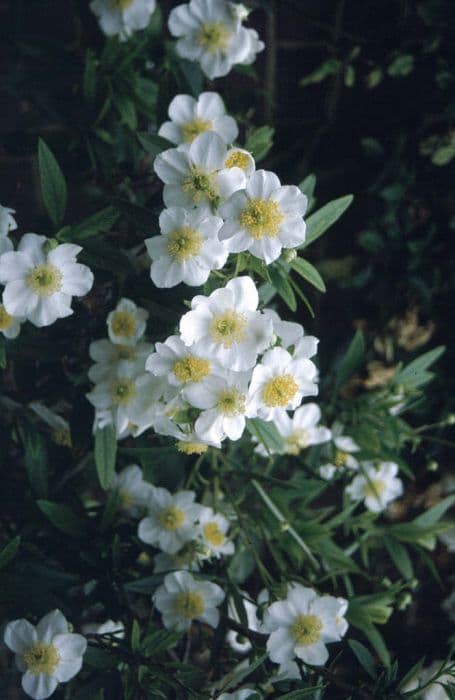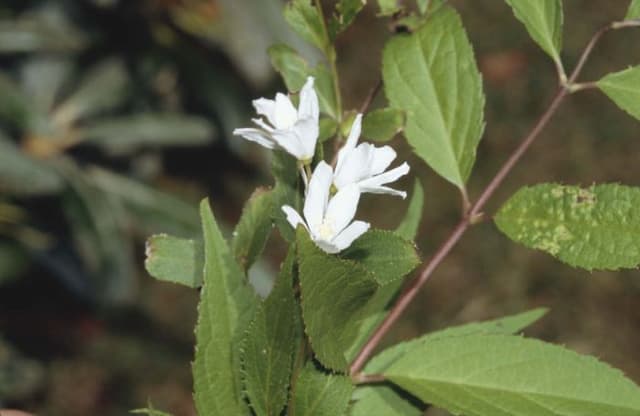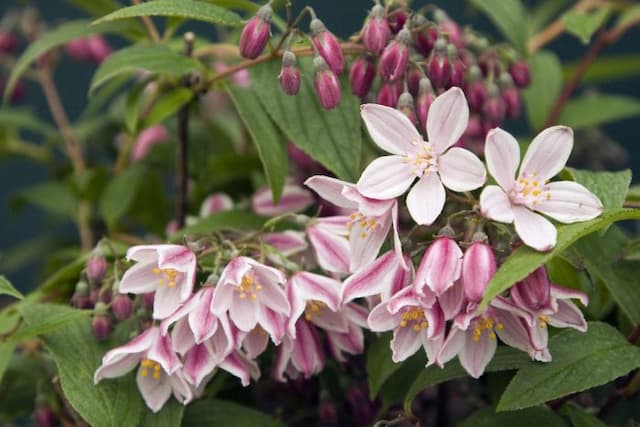Mini Penny Hydrangea Hydrangea macrophylla 'Pia' (H)

ABOUT
Hydrangea macrophylla 'Pia', commonly known as Pia hydrangea, is a compact flowering shrub known for its beautiful and abundant blooms. Its most distinguishing feature is the large, rounded clusters of flowers that emerge during the blooming period. These flower heads are known as mopheads; they are dense and fluffy, reminiscent of a soft brush or a mop. The blooms display rich and vibrant shades which can range from deep pink to purple, often influenced by the soil acidity. The leaves of the Pia hydrangea are thick with a somewhat leathery texture, broad and ovate, with pointed tips and serrated edges. They offer a nice green backdrop that contrasts strikingly with the showy flowers. The plant's stems are sturdy, supporting the weight of the blossoms and leaves. The blooms can last for several weeks and are a magnet for pollinators such as bees and butterflies. Overall, it displays a lush, verdant appearance, with a striking color contrast that makes it a standout in any garden setting.
About this plant
 Names
NamesFamily
Hydrangeaceae.
Synonyms
Mini Penny Hydrangea, Pia Hydrangea, Dwarf Bigleaf Hydrangea, Pink Elf French Hydrangea.
Common names
Hydrangea macrophylla 'Pia'.
 Toxicity
ToxicityTo humans
The Mophead hydrangea has parts that contain cyanogenic glycosides, which can release cyanide when chewed or digested. If ingested, these compounds can cause symptoms of poisoning, which typically include nausea, vomiting, and diarrhea. In severe cases, cyanide toxicity may lead to more serious effects such as dizziness, rapid breathing, and potentially, a drop in blood pressure, which could result in a coma or even be fatal if not treated promptly.
To pets
The Mophead hydrangea is toxic to pets due to the presence of cyanogenic glycosides found throughout the plant. When ingested by pets, it can cause symptoms of poisoning. These symptoms can include vomiting, diarrhea, lethargy, and depression. In serious cases, cyanide intoxication may occur, leading to more severe signs such as rapid breathing, increased heart rate, and seizures. If large enough quantities are consumed, this could potentially be fatal, making it important for pet owners to keep their animals away from this plant.
 Characteristics
CharacteristicsLife cycle
Perennials
Foliage type
Deciduous
Color of leaves
Green
Flower color
Pink
Height
3 feet (0.91 meters)
Spread
3 feet (0.91 meters)
Plant type
Shrub
Hardiness zones
6
Native area
Japan
Benefits
 General Benefits
General Benefits- Compact Size: 'Pia' is a dwarf variety, making it suitable for small gardens and containers.
- Long Blooming Period: Produces flowers from early summer to late fall, providing extended visual interest.
- Attractive Flowers: Offers showy pink blooms that can add a pop of color to any landscape.
- Drought Tolerance: Once established, it has moderate drought tolerance, reducing the need for frequent watering.
- Shade Tolerance: Can grow in partial shade, providing options for planting in various garden locations.
- Cold Hardiness: It is relatively cold hardy, which makes it suitable for growing in cooler climates.
- Attracts Pollinators: The flowers attract bees and other pollinators, promoting a healthy garden ecosystem.
- Soil pH Responsiveness: The flower color can change with soil pH, offering an educational aspect to gardening with this plant.
- Easy to Propagate: 'Pia' can be easily propagated through cuttings, allowing gardeners to create more plants.
- Minimal Pruning Required: Requires minimal pruning, which can help novice gardeners maintain the plant with ease.
 Medical Properties
Medical PropertiesThis plant is not used for medical purposes.
 Air-purifying Qualities
Air-purifying QualitiesThis plant is not specifically known for air purifying qualities.
 Other Uses
Other Uses- Water Indicator: Hydrangeas can be used as a natural water indicator for gardeners, as the leaves wilt when the plant needs water, helping to indicate the watering needs of nearby plants.
- Craft Colorant: The flowers of the hydrangea can be used to naturally dye fabrics or paper, offering a range of colors from pink to blue depending on the pH of the water used in the dyeing process.
- Aluminum Detector: The flower color can indicate the presence of aluminum in the soil; blue flowers suggest a higher aluminum content, which can be useful for assessing soil composition.
- Dried Arrangements: The blooms of hydrangea can be dried and used in floral arrangements, maintaining their shape and color for extended periods.
- Shade Garden Beautification: This variety of hydrangea is well-suited for planting in shady garden nooks where other plants may struggle to thrive, providing aesthetic enhancement with its lush foliage and flowers.
- Edging Plant: Use the compact size of Pia Hydrangeas to create attractive garden edges or borders, offering structured yet soft visual separation between different areas of the garden.
- Feng Shui: In Feng Shui, hydrangeas are considered a symbol of abundance and prosperity, and so they may be planted with the intention of promoting these qualities around the home.
- Rustic Art: Leaves and blooms can be used to make prints on paper or fabric, creating rustic and botanical-themed art pieces for home decoration.
- Theme Gardens: They can be included in a 'changing color' themed garden, where the focus is on plants that change colors throughout the seasons or in response to environmental factors.
- Garden Learning Aid: Pia Hydrangeas can be used as educational tools in gardens or schools to explain the concept of soil pH and its effect on plant physiology and bloom coloration.
Interesting Facts
 Feng Shui
Feng ShuiThe Mophead Hydrangea is not used in Feng Shui practice.
 Zodiac Sign Compitability
Zodiac Sign CompitabilityThe Mophead Hydrangea is not used in astrology practice.
 Plant Symbolism
Plant Symbolism- Heartfelt Emotions: Hydrangeas are often associated with genuine, heartfelt emotions and can represent anything from deep understanding to abundant love.
- Gratitude: The lush blooms can symbolize gratitude and are commonly given as a thank-you gesture.
- Apology: Sometimes hydrangeas imply an apology or a desire for reconciliation, particularly in a Japanese cultural context, where the pink varieties like 'Pia' are linked with genuine emotion.
- Vanity and Boastfulness: In some Victorian narratives, hydrangeas were a symbol of vanity and boastfulness, due to their showy and abundant flowers.
- Perseverance: The robust nature of the plant may signify perseverance, as it can endure a variety of climates and conditions.
- Fourth Anniversary: Hydrangeas, including the 'Pia' variety, are symbolic of the fourth wedding anniversary, representing appreciation and steadfastness.
 Water
WaterMiniature Hydrangeas need to be watered thoroughly, ensuring the soil is kept consistently moist but not waterlogged. They should be watered deeply about three times a week, depending on the climate and soil drainage. In hot or windy weather, you may need to water more frequently. Each watering session should involve slowly adding water until it begins to run out of the bottom of the pot or until the soil is saturated to a depth of 8 inches. It is imperative to adjust watering to about 1 to 1.5 gallons per session during the growing season and reduce the frequency during the dormant winter period.
 Light
LightMiniature Hydrangeas thrive best in partial shade where they can receive morning sunlight and afternoon shade. The ideal spot is one that exposes the plant to gentle morning rays while protecting it from the harsh afternoon sun. In regions with more overcast conditions, they can tolerate more sun, but the direct, intense midday sunlight should generally be avoided to prevent leaf scorch.
 Temperature
TemperatureMiniature Hydrangeas prefer moderate temperatures and can generally survive in temperatures as low as 30 degrees Fahrenheit and as high as 80 degrees Fahrenheit, but they grow best when temperatures are maintained between 65 to 70 Fahrenheit. Sudden frosts or extreme heat can severely damage or stress the plants, so they should be protected from drastic temperature shifts.
 Pruning
PruningPruning Miniature Hydrangeas is important to encourage robust growth and abundant blooms. They should be pruned after they have finished flowering, usually in late summer or early fall, but before they set bud for the next year. Remove any dead or weak stems as well as spent flowers to promote healthy growth and flowering for the following season.
 Cleaning
CleaningAs needed
 Soil
SoilHydrangea, commonly known as ‘Pia’, thrives in well-draining, moist soil enriched with organic matter. A soil mixture with equal parts garden soil, peat moss, and perlite is ideal. The soil pH should be maintained around 5.5 to have pink flowers or closer to 5.0 for bluer blooms, as this affects the flower color.
 Repotting
RepottingMiniature hydrangea 'Pia' should be repotted every two to three years to provide fresh soil and encourage growth. Spring is the best time to repot before the growing season begins.
 Humidity & Misting
Humidity & MistingMiniature hydrangea 'Pia' prefers high humidity levels, around 50-60%, but will tolerate average household humidity. Mist the leaves regularly to maintain adequate humidity if the air is dry.
 Suitable locations
Suitable locationsIndoor
Keep 'Pia' in bright, indirect light with moist soil.
Outdoor
Plant 'Pia' in partial shade with well-draining soil.
Hardiness zone
6-9 USDA.
 Life cycle
Life cycleThe Hydrangea macrophylla 'Pia', commonly known as Mini Penny Hydrangea, begins its life as a dormant, bare-root plant or as a seed. After planting, it enters a vegetative stage, during which the roots establish in the soil and foliage begins to develop. As it matures, the hydrangea enters a period of rapid growth, producing lush green leaves and eventually forming characteristic large flowers that can range in color from pink to blue, depending on soil acidity. The blossoming stage typically occurs in early summer and can last until the fall, attracting pollinators. Post-bloom, the plant enters a period of senescence; flowers fade, and the hydrangea prepares for dormancy by conserving energy and nutrients. With the arrival of winter, the hydrangea becomes dormant, shedding its leaves and surviving the cold until the cycle restarts with the spring warmth.
 Propogation
PropogationPropogation time
Spring-Early Summer
Propogation: Hydrangea macrophylla 'Pia', commonly known as Mini Penny hydrangea, is commonly propagated through softwood cuttings. This method is generally performed in late spring or early summer when new growth is still soft and green. To propagate, a 4 to 6 inch cutting is taken just below a leaf node, and the lower leaves are removed. The cut end is then dipped in rooting hormone to encourage root growth and planted in a moist potting mix. The cutting should be kept in a warm, humid environment with indirect sunlight until roots have developed, which typically takes 4 to 6 weeks. Once rooted, the cutting can be transplanted to a larger pot or directly into the garden.








![Hydrangea [Strong Annabelle]](/_next/image?url=https%3A%2F%2Fplants-admin.emdemapps.com%2Fimages%2Fplants%2F%2Fimages%2F604b54db37d34.png&w=640&q=75)
